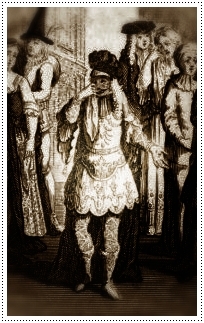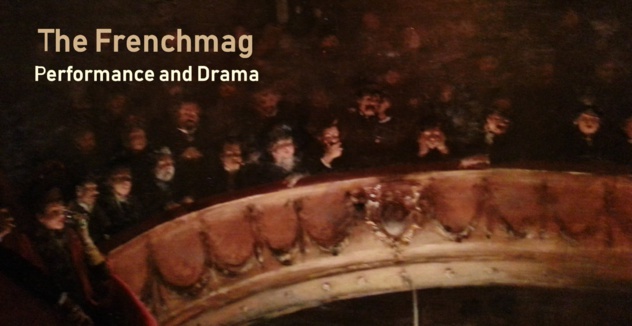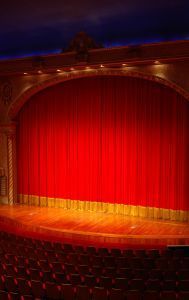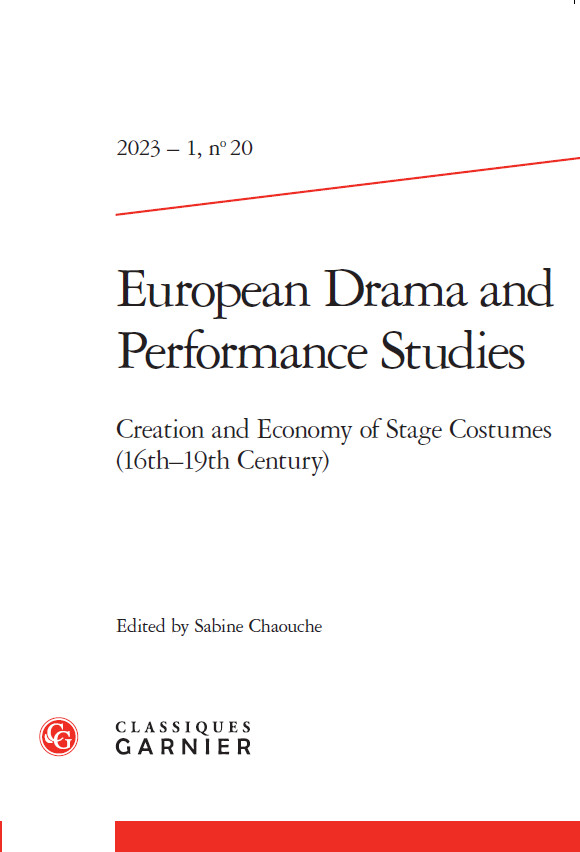
(c) B. Russell
In the Impromptu de Versailles, a play written in 1663, Molière did an impression of the Comédiens ordinaires du Roy, especially Montfleury, a fat and paunchy actor who was one of the most famous tragedians of his time. Molière criticised his way of declaiming and also of standing on stage: “Can you see this posture? Take a good look.”(1) The word ‘posture’ suggested that Montfleury’s body did not look natural and the criticism focused on the use of over-theatrical gestures. Molière seemed to insist on the fact that the tragedians of his time liked to display their technique to the audience in a conspicuous and ostentatious manner (2) . The enraged supporters of the Hôtel de Bourgogne quickly came up with a portrait of Molière’s performances in tragedy, in the play entitled L’Impromptu de l’Hôtel de Condé, which was written by Montfleury’s son:
He comes in looking upwards
His feet inwards and his shoulder forward
His wig is crooked
With hands on hips, he walks stiffly
Looking wild and with his head sticking up like that
Of an overloaded mule… (3)
This way of mocking actors, their acting style, but also inappropriate gestures on stage was taken up at the end of the seventeenth century by the Théâtre Italien (for instance in Les Chinois/ The Chinese by Jean-François Regnard and Charles Rivière Dufresny, 1697) and mostly in the first part of the eighteenth century by the fairground theatres (Saint-Germain and Saint-Laurent). As can be seen here, some aspects of Molière’s gestures and attitudes, as well as Montfleury’s ones, were not only over-emphasized but also caricatured. They do not seem totally realistic and true (Molière’s attitude appears to be quite hard to sustain for a long time), perhaps because the aim was just to ridicule one another by any means. Interestingly, criticisms aiming to promote “antitheatricalism” or “natural” could be regarded as a particular form of theatricalism. It seems that these impressions should not be taken into serious consideration since they do not give a clear and objective vision of gestures and movements and are attacks against an actor and a playhouse. To what extent can they be instructive? I will examine how criticisms on theatricalism can shed a new light on the conflict between traditional gestures and innovative acting which dominated the first part of the eighteenth century French Theatre.
He comes in looking upwards
His feet inwards and his shoulder forward
His wig is crooked
With hands on hips, he walks stiffly
Looking wild and with his head sticking up like that
Of an overloaded mule… (3)
This way of mocking actors, their acting style, but also inappropriate gestures on stage was taken up at the end of the seventeenth century by the Théâtre Italien (for instance in Les Chinois/ The Chinese by Jean-François Regnard and Charles Rivière Dufresny, 1697) and mostly in the first part of the eighteenth century by the fairground theatres (Saint-Germain and Saint-Laurent). As can be seen here, some aspects of Molière’s gestures and attitudes, as well as Montfleury’s ones, were not only over-emphasized but also caricatured. They do not seem totally realistic and true (Molière’s attitude appears to be quite hard to sustain for a long time), perhaps because the aim was just to ridicule one another by any means. Interestingly, criticisms aiming to promote “antitheatricalism” or “natural” could be regarded as a particular form of theatricalism. It seems that these impressions should not be taken into serious consideration since they do not give a clear and objective vision of gestures and movements and are attacks against an actor and a playhouse. To what extent can they be instructive? I will examine how criticisms on theatricalism can shed a new light on the conflict between traditional gestures and innovative acting which dominated the first part of the eighteenth century French Theatre.
Although the Comédiens du Roi were the only ones to have a privilege from the king and thus allowed to perform in Paris, the fairground theatres and later the Opera-comique directed by Jean Monnet became popular in the first half of the eighteenth century. The tensions between the Parisian companies, that is to say between non official troupes and the official one were quite intense. In this context many productions at the fairgrounds and the Opera-comique were focused on their rivals’ acting, especially tragic acting which was not part of the repertoire or the genre of the opera-comique as it mixed music, dance, songs and comic acting. One of the most satirical plays was Acajou, performed in 1744 at the Opéra-comique. Charles Simon Favart described the gestures of the actors, scene 3:
Look at me: this is how I walk, then
I choose a posture and begin in a whisper
I raise my voice gradually to a shout
As I swing my body and wave my arms […].
Sometimes as I join both my arms in a circle in front of me,
I impress the crowds with the solemn voice of a king
And bellow my lines with muffled tone.
Actresses, if you want to be acclaimed on the stage
You must declaim madly from the first
Stretch your arm to better display it
Thrust out your chest and then wave your handkerchief
Shout at all times, shout until you are breathless
In a nutshell, we want to hear an infuriated Melpomene. (4)
In this extract, Favart criticized tragedians who would limit themselves to conventional postures (in this respect the type of criticism does not differ from Molière’s time). He considered that gestures in tragedy (thus at the Comédie-Française) were mechanical but also too affected and stilted. Here, the actor seems to demonstrate different passions rather than acting passions. There is no correlation between what is said and what is performed. Stage-effects seem to be based on stylized and expressive movements which can be reused independently of the situation or what is actually performed (which can vary from time to time and from day to day). They could be compared to what Torstov will later depict in An actor prepares as “an external portrayal of images and passions”(5) because gestures are related to solely composition: they are entirely staged and lead to the feeling of an artificial performance (and an actor who looks like an automaton). Favart certainly emphasized the caricature by describing ludicrous attitudes which have no transitions or real purpose — except to impress and make the audience laugh. In this extract female actors are even more affected since their gestures are combined with a touch of coquetry.
Look at me: this is how I walk, then
I choose a posture and begin in a whisper
I raise my voice gradually to a shout
As I swing my body and wave my arms […].
Sometimes as I join both my arms in a circle in front of me,
I impress the crowds with the solemn voice of a king
And bellow my lines with muffled tone.
Actresses, if you want to be acclaimed on the stage
You must declaim madly from the first
Stretch your arm to better display it
Thrust out your chest and then wave your handkerchief
Shout at all times, shout until you are breathless
In a nutshell, we want to hear an infuriated Melpomene. (4)
In this extract, Favart criticized tragedians who would limit themselves to conventional postures (in this respect the type of criticism does not differ from Molière’s time). He considered that gestures in tragedy (thus at the Comédie-Française) were mechanical but also too affected and stilted. Here, the actor seems to demonstrate different passions rather than acting passions. There is no correlation between what is said and what is performed. Stage-effects seem to be based on stylized and expressive movements which can be reused independently of the situation or what is actually performed (which can vary from time to time and from day to day). They could be compared to what Torstov will later depict in An actor prepares as “an external portrayal of images and passions”(5) because gestures are related to solely composition: they are entirely staged and lead to the feeling of an artificial performance (and an actor who looks like an automaton). Favart certainly emphasized the caricature by describing ludicrous attitudes which have no transitions or real purpose — except to impress and make the audience laugh. In this extract female actors are even more affected since their gestures are combined with a touch of coquetry.
Here Favart stressed mainly the role played by the arms in acting and how they were a major way to express emotions and literally mime a tragic situation. A misuse of them could give wrong impressions to the audience and turn tragedy into comedy – or even a puppet show.
This distorted portrait, staging fervent exponents of codified gestures, relates to theatrical traditions which go back to actio oratoria and rhetoric and which were not understood as a form of theatricalism. They were rediscovered in the seventeenth-century and were promoted. Most of the works published during the period gave orators prescribed rules and positions. One of the main points of the art of the silent eloquence was to focus the attention of the audience on the upper part of the body (from head to waist). The rules were quite strict. Gestures above the head or below the stomach were not tolerated. Neither were immoderate movements. On the contrary dignity and majesty were required. Gestures had to avoid becoming a pantomime or to being disconnected from the text. They would stop at the end of each sentences or speech. They were designed to be didactic. They had to help the understanding of words and sentences, and give a visual representation of what was being said. They could potentially be regarded as irrelevant if they merely echoed the lines or the discourse. Improvisation was banned as well as pure mimics or mime. Thus in the eighteenth century Prince Charles Joseph de Ligne was still recommending that: “actors should not imitate the dragon with its crooked back, nor should they mime the receding tide.” (6) The use of gestures aiming to embody passions rather than actually be the manifestations of passions through the body was gradually rejected in the eighteenth century, perhaps because such gestures were mercilessly ridiculed by the fairgrounds. This may have had an impact on the behaviour of Parisians and on Parisian theatrical trends.
In 1764/74 Servandoni d’Hannetaire not only forbade actors to “follow the ridiculous Italian style”, i.e. mime but he also encouraged them to reject any symbolic gesture where “sensitivity was expressed by simply putting one hand on the chest”. To point to the heart was not a good way to express and perform emotions. From then on, this acting style was seen as puerile and unprofessional. (7)
Exaggerated postures or movements were considered as poor acting since they recalled histrionic attitudes. “To thrust out the chest”, “to wave the body”, “being too excitable” were all attitudes commonly condemned by rhetoricians (we already find references to them in the Institutio oratoria by Quintilian). Stories of actors falling victim to violent movements and strong agitation on stage were also well known: Montfleury collapsed while performing Oreste’s furors in Andromaque by Jean Racine; earlier in the seventeenth-century, Montdory’s tongue became suddenly paralyzed in La Mariane by Tristan.
This distorted portrait, staging fervent exponents of codified gestures, relates to theatrical traditions which go back to actio oratoria and rhetoric and which were not understood as a form of theatricalism. They were rediscovered in the seventeenth-century and were promoted. Most of the works published during the period gave orators prescribed rules and positions. One of the main points of the art of the silent eloquence was to focus the attention of the audience on the upper part of the body (from head to waist). The rules were quite strict. Gestures above the head or below the stomach were not tolerated. Neither were immoderate movements. On the contrary dignity and majesty were required. Gestures had to avoid becoming a pantomime or to being disconnected from the text. They would stop at the end of each sentences or speech. They were designed to be didactic. They had to help the understanding of words and sentences, and give a visual representation of what was being said. They could potentially be regarded as irrelevant if they merely echoed the lines or the discourse. Improvisation was banned as well as pure mimics or mime. Thus in the eighteenth century Prince Charles Joseph de Ligne was still recommending that: “actors should not imitate the dragon with its crooked back, nor should they mime the receding tide.” (6) The use of gestures aiming to embody passions rather than actually be the manifestations of passions through the body was gradually rejected in the eighteenth century, perhaps because such gestures were mercilessly ridiculed by the fairgrounds. This may have had an impact on the behaviour of Parisians and on Parisian theatrical trends.
In 1764/74 Servandoni d’Hannetaire not only forbade actors to “follow the ridiculous Italian style”, i.e. mime but he also encouraged them to reject any symbolic gesture where “sensitivity was expressed by simply putting one hand on the chest”. To point to the heart was not a good way to express and perform emotions. From then on, this acting style was seen as puerile and unprofessional. (7)
Exaggerated postures or movements were considered as poor acting since they recalled histrionic attitudes. “To thrust out the chest”, “to wave the body”, “being too excitable” were all attitudes commonly condemned by rhetoricians (we already find references to them in the Institutio oratoria by Quintilian). Stories of actors falling victim to violent movements and strong agitation on stage were also well known: Montfleury collapsed while performing Oreste’s furors in Andromaque by Jean Racine; earlier in the seventeenth-century, Montdory’s tongue became suddenly paralyzed in La Mariane by Tristan.
The recurrence of these images over a long period of time suggests that the criticisms made implicitly by Favart were conventional, that is to say clichés on their own, since such movements and gestures were already described in actio oratoria, and regarded as a “no-no”. This way of mocking tragedians was traditional indeed and was reminiscent of the methods used by Molière and Montfleury during their quarrel. They should not be taken into consideration too seriously since they suggest that acting did not evolve at all over a century. It seems that criticism on theatricalism was just a game or a way of staging the Theatrical –i.e. to show theatricality as an art form. The intention was solely to amuse the audience and make money.
Finally, the fairgrounds’ caricatures were not necessarily a faithful depiction of the tragedians from the Comédie-Française since few tragedians from the Comédie-Française were criticised between 1715 and 1762. On the contrary, they were most often praised and admired such as Mlle Deseine, Mlle Lecouvreur, Mlle Gaussin, Mlle Dumesnil, Mlle Clairon, Michel Baron, Jean-Baptiste Brisard, Alexis Quinault-Dufresne etc. Criticisms do not explain how tragic acting evolved over the century. However, they had positive results by impacting on acting at the Comédie-Française. Since they were popular, they could not be ignored by the tragedians who most probably tried avoiding affected gestures and to be more innovative.
Sabine Chaouche
Acknowledgments: Many thanks to Monique Moreton for proofreading and help with translations.
Finally, the fairgrounds’ caricatures were not necessarily a faithful depiction of the tragedians from the Comédie-Française since few tragedians from the Comédie-Française were criticised between 1715 and 1762. On the contrary, they were most often praised and admired such as Mlle Deseine, Mlle Lecouvreur, Mlle Gaussin, Mlle Dumesnil, Mlle Clairon, Michel Baron, Jean-Baptiste Brisard, Alexis Quinault-Dufresne etc. Criticisms do not explain how tragic acting evolved over the century. However, they had positive results by impacting on acting at the Comédie-Française. Since they were popular, they could not be ignored by the tragedians who most probably tried avoiding affected gestures and to be more innovative.
Sabine Chaouche
Acknowledgments: Many thanks to Monique Moreton for proofreading and help with translations.
(1) “Voyez-vous cette posture? Remarquez bien cela.” Molière, L’Impromptu de Versailles, [1663], ed. G. Forestier (Paris: Gallimard, 2010), sc. 3.
(2)“On appelle Danses de postures, Celles où les danseurs affectent certaines postures bizarres. On dit, Faire des postures de bateleur, de baladin, pour dire, Imiter leurs postures.” (Acad. 4e ed.)
(3) French version:
“Il est fait tout de même ; il vient le nez au vent,
Les pieds en parenthèse, & l’épaule en avant,
Sa perruque suit le côté qu’il avance,
Plus pleine de lauriers qu’un jambon de Mayence,
Les mains sur les côtés d’un air peu négligé,
La tête sur le dos comme un mulet chargé,
Les yeux fort égarés, puis débitant ses rôles,
D’un hoquet éternel sépare ses paroles.
Montfleury, A. J., L’Impromptu de l’Hôtel de Condé, comédie, Paris, N. Pépingué, 1664 ; (in) Œuvres Complètes de Molière, éd. Georges Couton, Bibliothèque de la Pléiade (Paris: Gallimard, 1971), I, 1114-1124, sc. 3.
(4) French version:
“Examinez mon jeu : c’est ainsi que j’avance,
Je prends une attitude & fort bas je commence,
Ma voix en même temps s’élève par éclats,
Je balance le corps & j’agite les bras. […]
Tantôt de mes deux bras décrivant un ovale,
J’en impose aux humains du ton sacré des Rois,
Et je mugis des Vers en étouffant ma voix.
Actrices qui briguez les honneurs de la Scene,
Que dès le premier vers la fureur vous entraîne,
Etendez votre bras pour mieux le faire voir,
Relevez l’estomach, étalez le mouchoir,
Criez à tout propos, criez à perdre haleine,
Que l’on croye en un mot voir hurler Melpomene.”
Charles-Simon Favart, Acajou, opéra-comique [imitated from "Acajou et Zirphile", by C. Duclos], par M. Favart... [Paris, Théâtre du faux-bourg Saint-Germain, 18 mars 1744.] (Paris: Prault fils, 1744), I.4.
(5) Stanislavski, C., 1936. An Actor prepares (London: A. and C. Black publishers, 2006), 312.
(6) Prince de Ligne about Théramène : “il ne faut jouer ni le dragon à croupe recourbée, ni le flot qui recule” (Lettres à Eulalie, in Mélanges Littéraires, militaires et sentimentaires (Vienne, Dresde: Walther), 1696, letter 7)
(7) “Enfin j’ajouterai ici un dernier avis aux Gesticulateurs : c’est d’éviter, et de laisser aux Acteurs Italiens, cette puérile exactitude du geste à la chose, comme font la plupart de nos Comédiens qui, pour mieux exprimer, par exemple, la sensibilité du cœur ou autres passions de l’âme, ne manquent jamais de s’appliquer fortement la main sur la poitrine ; comme si effectivement il était question du cœur physique en cette occasion.” (Observations sur l’art du comédien (Paris: s.d., 1774), 207).
(2)“On appelle Danses de postures, Celles où les danseurs affectent certaines postures bizarres. On dit, Faire des postures de bateleur, de baladin, pour dire, Imiter leurs postures.” (Acad. 4e ed.)
(3) French version:
“Il est fait tout de même ; il vient le nez au vent,
Les pieds en parenthèse, & l’épaule en avant,
Sa perruque suit le côté qu’il avance,
Plus pleine de lauriers qu’un jambon de Mayence,
Les mains sur les côtés d’un air peu négligé,
La tête sur le dos comme un mulet chargé,
Les yeux fort égarés, puis débitant ses rôles,
D’un hoquet éternel sépare ses paroles.
Montfleury, A. J., L’Impromptu de l’Hôtel de Condé, comédie, Paris, N. Pépingué, 1664 ; (in) Œuvres Complètes de Molière, éd. Georges Couton, Bibliothèque de la Pléiade (Paris: Gallimard, 1971), I, 1114-1124, sc. 3.
(4) French version:
“Examinez mon jeu : c’est ainsi que j’avance,
Je prends une attitude & fort bas je commence,
Ma voix en même temps s’élève par éclats,
Je balance le corps & j’agite les bras. […]
Tantôt de mes deux bras décrivant un ovale,
J’en impose aux humains du ton sacré des Rois,
Et je mugis des Vers en étouffant ma voix.
Actrices qui briguez les honneurs de la Scene,
Que dès le premier vers la fureur vous entraîne,
Etendez votre bras pour mieux le faire voir,
Relevez l’estomach, étalez le mouchoir,
Criez à tout propos, criez à perdre haleine,
Que l’on croye en un mot voir hurler Melpomene.”
Charles-Simon Favart, Acajou, opéra-comique [imitated from "Acajou et Zirphile", by C. Duclos], par M. Favart... [Paris, Théâtre du faux-bourg Saint-Germain, 18 mars 1744.] (Paris: Prault fils, 1744), I.4.
(5) Stanislavski, C., 1936. An Actor prepares (London: A. and C. Black publishers, 2006), 312.
(6) Prince de Ligne about Théramène : “il ne faut jouer ni le dragon à croupe recourbée, ni le flot qui recule” (Lettres à Eulalie, in Mélanges Littéraires, militaires et sentimentaires (Vienne, Dresde: Walther), 1696, letter 7)
(7) “Enfin j’ajouterai ici un dernier avis aux Gesticulateurs : c’est d’éviter, et de laisser aux Acteurs Italiens, cette puérile exactitude du geste à la chose, comme font la plupart de nos Comédiens qui, pour mieux exprimer, par exemple, la sensibilité du cœur ou autres passions de l’âme, ne manquent jamais de s’appliquer fortement la main sur la poitrine ; comme si effectivement il était question du cœur physique en cette occasion.” (Observations sur l’art du comédien (Paris: s.d., 1774), 207).




